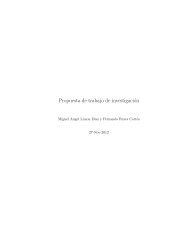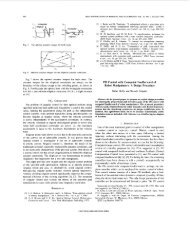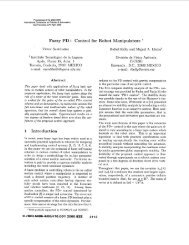2001 Santibañez - Global asymptotic stability of bounded output feedback tracking control for robot manipulators.pdf
2001 Santibañez - Global asymptotic stability of bounded output feedback tracking control for robot manipulators.pdf
2001 Santibañez - Global asymptotic stability of bounded output feedback tracking control for robot manipulators.pdf
You also want an ePaper? Increase the reach of your titles
YUMPU automatically turns print PDFs into web optimized ePapers that Google loves.
Proceeding 01 the 40th IEEE<br />
Conference on Decision and Control<br />
Orlando, Florida USA, December <strong>2001</strong><br />
WeA03-5<br />
<strong>Global</strong> Asymptotic Stability <strong>of</strong> Bounded Output Feedback<br />
Tracking Control <strong>for</strong> Robot Manipulators'<br />
Victor Santibacez<br />
Rafael Kelly<br />
Instituto Tecnolbgico de la Laguna Divisibn de Fisica Aplicada<br />
Apdo. Postal 49 Adm. 1<br />
CICESE<br />
Torrebn Coahuila, 27001 Apdo. Postal 2615, Adm. 1<br />
MEXICO Ensenada, B. C., 22800<br />
e-mail: vsantiba@itla6aguna.edu.mx<br />
MEXICO<br />
e-mail: rkelly@cicese.mx<br />
Abstract<br />
This note shows that global <strong>asymptotic</strong> <strong>stability</strong> <strong>of</strong><br />
the closed-loop system <strong>for</strong>med by an <strong>output</strong> <strong>feedback</strong><br />
<strong>tracking</strong> hounded <strong>control</strong>ler (previously reported in the<br />
literature) <strong>for</strong> <strong>robot</strong> <strong>manipulators</strong> in presence <strong>of</strong> sufficiently<br />
large viscous friction, can be achieved provided<br />
that a feed<strong>for</strong>ward compensation term <strong>of</strong> the viscous<br />
friction is added to the <strong>control</strong>ler.<br />
Keywords: TYacking, Robot <strong>control</strong>, Bounded <strong>output</strong><br />
<strong>feedback</strong> <strong>control</strong>, Lyapunov's second method.<br />
1 Introduction and <strong>robot</strong> dynamics<br />
In contrast with the <strong>bounded</strong> torque inputs set-point<br />
<strong>control</strong> problem <strong>of</strong> <strong>robot</strong> <strong>manipulators</strong> -which has<br />
been the subject <strong>of</strong> several researches [1]-[8]- the<br />
<strong>bounded</strong> <strong>tracking</strong> <strong>control</strong> problem has been treated by<br />
few authors, namely; [9], and [lo]. For the latter prob<br />
lem, to the best <strong>of</strong> the authors' knowledge, until now<br />
only semi-global <strong>asymptotic</strong> <strong>stability</strong> has been ensured.<br />
This note considers the problem <strong>of</strong> designing a global<br />
<strong>tracking</strong> <strong>control</strong>ler <strong>for</strong> <strong>robot</strong> <strong>manipulators</strong> under the<br />
constraints that only joint position measurements are<br />
available (<strong>output</strong> <strong>feedback</strong>) and the input torques are<br />
<strong>bounded</strong> by prescribed limits. To this end we resort<br />
to the <strong>tracking</strong> <strong>control</strong>ler proposed in [lo]. We prove,<br />
under the only requirement <strong>of</strong> having sufficient viscous<br />
friction in the <strong>robot</strong> manipulator joints, such a <strong>control</strong>ler<br />
is effective to achieve global <strong>asymptotic</strong> <strong>stability</strong><br />
provided that viscous friction is feed<strong>for</strong>ward compensated<br />
by the <strong>control</strong>ler.<br />
Throughout this note, we use the notation X,{A}<br />
and Xy{A} to indicate the smallest and largest eigenvalues,<br />
respectively, <strong>of</strong> a symmetric positive defi-<br />
'Work partidly supported by COSNET and CONACyT<br />
grants No. 31948-A and 32613-A.<br />
0=1803=106i-9mi~io.cm e, <strong>2001</strong> IEEE 1370<br />
nite <strong>bounded</strong> matrix A(z), <strong>for</strong> any I E R". The<br />
norm <strong>of</strong> vector I is defined as 11111 = a.<br />
The vector function tanh(z) E R" is defined as:<br />
tanh(z) = [tanh(zl) ... tanh(zn)lT, where I =<br />
[.I z* '' ' z,]T E R".<br />
In presence <strong>of</strong> viscous friction, the dynamics <strong>of</strong> a serial<br />
n-link rigid <strong>robot</strong> can be written as [ll]:<br />
M(q)ii + C(q, d9 + Fil+ g(n) = T (1)<br />
where q is the n x 1 vector <strong>of</strong> joint displacements, q<br />
is the n x 1 vector <strong>of</strong> joint velocities, T is the n x 1<br />
vector <strong>of</strong> applied torques, M(q) is the n x n symmetric<br />
positive definite manipulator inertia matrix, C(q, q) is<br />
the n x n matrix <strong>of</strong> centripetal and Coriolis torques, F<br />
is the n x n constant, diagonal positive definite, viscous<br />
friction coefficient matrix, and g(q) is the n x 1 vector<br />
<strong>of</strong> gravitational torques.<br />
We assume that the links are jointed together with revolute<br />
joints. Some important and well known properties<br />
<strong>of</strong> dynamics (1) are the following: 1.-) There exists<br />
a positive constant kc such that: IlC(z,p)xll <<br />
kcllyll llzll V z,p, z E R". 2.-) There exists a positive<br />
constant kl such that: 11g(z)11 5 kl <strong>for</strong> all I E R".<br />
2 Control problem <strong>for</strong>mulation<br />
We shall denote the desired joint trajectory by qd(t)<br />
which is chosen twice continuously differentiable such<br />
that 4d(t) satisfies Il@d(t)ll, Ikd(t)ll> Ilqd(t)ll 5 Bdr with<br />
Bd being a finite constant. The position and velocity<br />
errors will he denoted by q = qd - q and qd = qd - Q,<br />
respectively.<br />
For the system (1) assume that only position measurements<br />
are available and that the <strong>robot</strong> inputs are constrained<br />
to<br />
[Til 5<br />
Vi = l,.. . ,n<br />
(2)
where ri stands <strong>for</strong> the i-th entry <strong>of</strong> vector r and<br />
7rnax IS . the allowed maximum torque. Then, the goal<br />
is to find an <strong>output</strong> <strong>feedback</strong> <strong>control</strong>ler which renders<br />
the closed-loop system globally <strong>asymptotic</strong>ally<br />
stable. It implies that <strong>for</strong> all initial conditions we have<br />
limt,, q(t) = 0.<br />
To solve this problem we present the following:<br />
Proposition. Consider the <strong>robot</strong> dynamics (1) under<br />
input constraints (2) and assume<br />
7”’- > Bd [XM{M} + kcBd + XM{F)] + ki. (3)<br />
Consider the <strong>control</strong> law<br />
r = Kp tanh(q) + K, tanh(t9) (4)<br />
+M(q)@d + C(q,qd)@d +<br />
+g(q)?<br />
i = -Atanh(x +Bq), (5)<br />
t9 = %+Bq, (6)<br />
where A, B, Kp and K” E IR”’“ are diagonal positive<br />
definite matrices. Then, the <strong>robot</strong> dynamics<br />
(1) in closed-loop with (4)-(6) is uni<strong>for</strong>mly globally<br />
<strong>asymptotic</strong>ally stable provided that the viscous friction<br />
is enough large in the sense that matrix F satisfies<br />
Xrn{F} > 3kCBd.<br />
Outline <strong>of</strong> the pro<strong>of</strong>. The pro<strong>of</strong> follows the same<br />
steps used in [lo]. The feed<strong>for</strong>ward friction viscous<br />
compensation term Fq,, in (4) is the only difference<br />
with respect to <strong>control</strong>ler introduced in [lo]. This modifies<br />
the corresponding closed-loop equation adding the<br />
term -F$, which is the key to obtain globality <strong>of</strong> the<br />
<strong>asymptotic</strong> <strong>stability</strong>.<br />
3 Conclusions<br />
0<br />
<strong>control</strong>s”, in Proc. IEEE Int. Conf. Robotics and Automation,<br />
Albuquerque, NM, Apr. 1997, pp. 1148-<br />
1155.<br />
(21 R. Gorez, “<strong>Global</strong>ly stable PID-like <strong>control</strong> <strong>of</strong><br />
mechanical systems”, Systems €4 Control Letters, vol.<br />
38, pp. 61-72, 1999.<br />
[3] R. Kelly and V. Santibafia, “A class <strong>of</strong> global<br />
regulators with <strong>bounded</strong> <strong>control</strong> actions <strong>for</strong> <strong>robot</strong> <strong>manipulators</strong>”,<br />
in Pmc. IEEE Conf. Decision and Control,<br />
Kobe, Japan, Dec. 1996, pp. 3382-3387.<br />
[4] A. Laib, “ Adaptive <strong>output</strong> regulation <strong>of</strong><br />
<strong>robot</strong> <strong>manipulators</strong> under actuator constraints”, IEEE<br />
Trans. Robot. Automat., Vol. 16, pp. 29-35, Feb. 2000.<br />
[5] A. Loria, R. Kelly, R. Ortega and V. Santibafiez,<br />
‘’ On global <strong>output</strong> <strong>feedback</strong> regulation <strong>of</strong> Euler-<br />
Lagrange systems with <strong>bounded</strong> inputs”, IEEE Tmns.<br />
Automat. Contr., vol. 42, pp. 113&1143, Aug. 1997.<br />
[GI V. Santibaiiez and R. Kelly, “On <strong>Global</strong> regulation<br />
<strong>of</strong> <strong>robot</strong> <strong>manipulators</strong>: saturated linear state <strong>feedback</strong><br />
and saturated linear <strong>output</strong> <strong>feedback</strong>”, European<br />
Journal <strong>of</strong> Control, vol. 3, pp. 104-113,1997.<br />
[7] V. Santibafiez and R. Kelly, “A New set-point<br />
<strong>control</strong>ler with <strong>bounded</strong> torques <strong>for</strong> <strong>robot</strong> <strong>manipulators</strong>’’,<br />
IEEE Transactions on Industrial Electronics,<br />
vol. 45, pp. 126-133, Feb. 1998.<br />
[8] E. Zergeroglu, W. Dixon, A. Behal and D. Dawson,<br />
“Adaptive set-point <strong>control</strong> <strong>of</strong> <strong>robot</strong>ic <strong>manipulators</strong><br />
with amplitude-limited <strong>control</strong> inputs”, Robotica,<br />
vol. 18, pp. 171-181, 2000.<br />
[9] W. E. Dixon, M. S. de Queiroz, F. Zhang and D.<br />
M. Dawson, “’Backing <strong>control</strong> <strong>of</strong> <strong>robot</strong> <strong>manipulators</strong><br />
with <strong>bounded</strong> torque inputs”, Robotica, vol. 17, pp.<br />
121-129, 1999.<br />
[lo] A. Loria and H. Nijmeijer, “Bounded <strong>output</strong><br />
<strong>feedback</strong> <strong>tracking</strong> <strong>control</strong> <strong>of</strong> fully actuated Euler-<br />
Lagrange systems”, Systems # Control Letters, vol. 33,<br />
pp. 151-161, 1998.<br />
[ll] Spong M. and M. Vidyasagar, Robot Dynamics<br />
and Control. John Wiley and Sons, New York, 1989.<br />
We have shown that considering the <strong>robot</strong> manipulator<br />
dynamics in presence <strong>of</strong> sufficiently large viscous<br />
friction, it is possible to ensure uni<strong>for</strong>m global<br />
<strong>asymptotic</strong> <strong>stability</strong> <strong>of</strong> the closed-loop system <strong>for</strong>med<br />
with the <strong>bounded</strong> <strong>output</strong> <strong>feedback</strong> <strong>tracking</strong> <strong>control</strong>ler,<br />
introduced in [lo], if it is added to a<strong>for</strong>ementioned<br />
<strong>control</strong>ler a feed<strong>for</strong>ward viscous friction compensation<br />
term. That means, that having access only to position<br />
measurements, and independently <strong>of</strong> the initial conditions,<br />
the <strong>tracking</strong> position error may go to zero and<br />
the torque inputs remain <strong>bounded</strong> by prescribed limits.<br />
References<br />
[l] R. Colbaugh, E. Barany and K Glass, “<strong>Global</strong><br />
regulation <strong>of</strong> uncertain <strong>manipulators</strong> using <strong>bounded</strong><br />
1379





